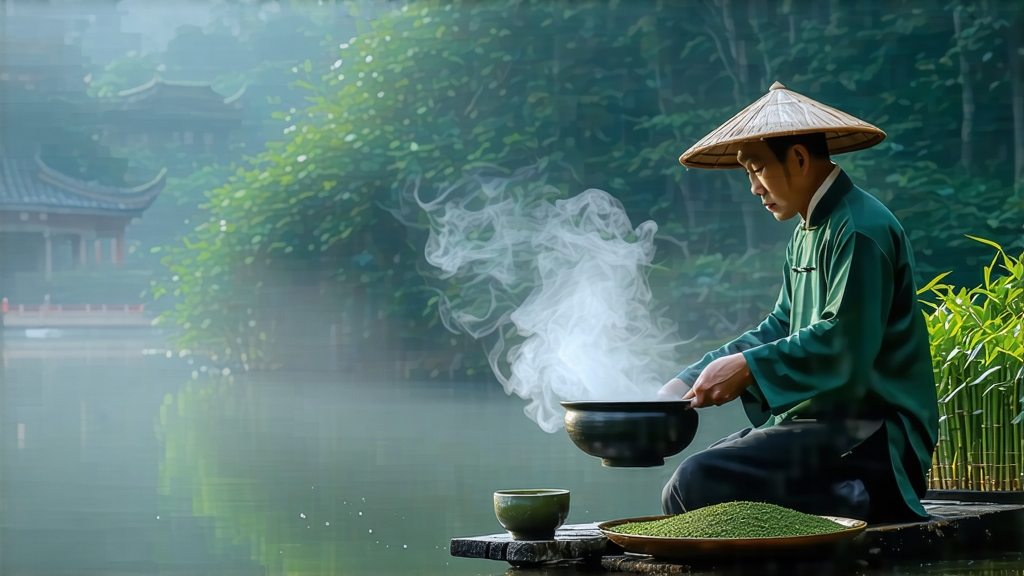
Longjing, literally “Dragon-Well,” is not merely a green tea; it is a liquid manuscript of Chinese history, geography and aesthetics. First recorded in the Tang dynasty (618-907) but catapulted to fame during the Qing (1644-1912) when the Qianlong Emperor allegedly bestowed imperial status upon eighteen bushes still growing near Lion Peak, Longjing has become the benchmark against which all Chinese green teas are measured. Its tiny, jade-colored leaves carry the scent of early April mist rising off West Lake in Hangzhou, the only terroir officially recognized by China’s 2001 geographical-indication law. To understand Longjing is therefore to sip the geography of a 6,500-hectare micro-zone where camellia sinensis var. sinensis has conversed with silty loam, moderate acidity, 1,600 mm annual rainfall and the lake’s reflective humidity for over a millennium.
Within the protected zone, five sub-appellations express distinct personalities. Shi-feng (Lion Peak) produces the most sought-after leaves: small, sword-shaped and densely covered in silvery pekoe, yielding a chestnut-sweet liquor whose orchid fragrance lingers like a faint gong note. Mei-jia-wu, a saddle-shaped valley, offers a slightly broader leaf, greener infusion and lighter, bean-sprout aroma. Weng-jia-shan gives a faintly marine hint, while Tiger-Run and Yun-qi temper mineral briskness with floral roundness. Beyond these core villages, neighboring counties such as Xin-chang and Song-yang craft “Zhejiang Longjing,” pleasant yet legally barred from bearing the West Lake seal. Authentic pre-Qingming (before 5 April) Shi-feng Longjing can command over 10,000 yuan per 500 g, not because marketers decree it, but because a single experienced picker gathers only 300 g of fresh leaf in a dawn shift, and 3.5 kg of fresh leaf are required for 500 g of finished tea.
The crafting choreography has changed little since the Qing. Picking begins when the dawn thermometer hovers at 12-15 °C and two leaves embrace a bud no longer than 2.5 cm. Baskets are woven from thin bamboo slats precisely to discourage bruising. Within four hours the harvest reaches the village work-shed where 250 °C woks await. “Green killing” (sha-qing) lasts only twelve to fifteen minutes; the master’s bare hand flips the leaf against the iron, feeling for the moment cellular respiration stops and grassy notes evaporate. The temperature is then dialed down to 80 °C for the ten-minute hui-chao “return-fry,” shaping the famous flat spear. A final twenty minutes at 60 °C sets moisture to 5-6 % while the leaf’s internal pressure creates the microscopic fissures that will release aroma in your cup. No rollers, no ovens, no mechanized mimicry can reproduce the wrist-born pressure that convinces each leaf to lie flat yet remain unbroken.
To brew Longjing is to negotiate between reverence and precision. Begin with soft water whose mineral content stays below 100 ppm; Hangzhou locals collect morning dew from bamboo gutters, but filtered spring water suffices. Heat to 80 °C—any hotter scalds the amino acids, any cooler under-extracts the catechins. A tall, thin-walled glass (ideally 200 ml) allows the “tea dance” to unfold: three grams of leaf, or roughly a level teaspoon, are sprinkled across the bottom. Pour water in a slow spiral so that every leaf is baptized simultaneously. Within thirty seconds the spears stand upright, then drift down in slow motion like miniature green submarines, a phenomenon connoisseurs call “the standing forest.” After two minutes 70 % of polyphenols have dissolved, gifting a pale chartreuse liquor. Do not decant; instead sip directly from the glass, replenishing with 85 °C water when half remains. Quality leaf endures four infusions: the first offers fresh soybean milk and sweet corn; the second, toasted chestnut; the third, faint orchid; the fourth, river-stone minerality before gracefully bowing out.
Tasting Longjing engages every sense. Sight: dry leaves should be jade-green with a matte, almost waxy sheen; any yellow tinge betrays over-firing. Touch: slide